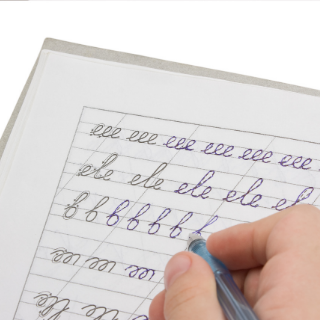
This language lesson is designed for 6 to 12-year-old children to guide them on how to write English alphabets n and m in cursive.
Cursive writing is a foundation skill that helps children build confidence, strengthen finger muscles and develop hand-eye coordination. It also increases their cognitive ability to recognize patterns and flow.
Although at the age of tablets, cursive writing may seem like a different era but it is still an important skill for children to learn today. It extends well beyond the classroom, which makes cursive instruction essential for children’s success.
In Montessori, cursive writing is introduced using letter families rather than in alphabetical order, because letters are created by joining lines and curves in a particular way. There is a designated starting point, along with a set of directional pushes and pulls to reach the designated finish point.
The Cursive Letter Families
A letter family is created by using sets of letters that are produced in a similar way. The letter families are the related letters kept in groups or families based on their common curve formation, just like an actual family. A letter family plan is a powerful tool for helping children remember and use the proper cursive formation. Here are the families of cursive letters.
- Hump family has 4 letters – n, m, v, and y.
- Bump Family includes 2 letters x and z.
- Loop family that includes letters b, h, f, k, l, and e.
- The c family wherein the letters taught are c, a, d, o, g, and q
- Up and down stroke family which has the letters j, p, r, w, u, s, t, and i.
The letters in cursive are taught in this pattern to make it easier for the child to attain good handwriting.
How to Write the Letters n and m in Cursive?
The best way to begin writing letters n and m in cursive is to trace them using sandpaper letters and then practice on a rice tray or sand tray and finally, write on paper/ notebook. In this video, the letters n and m are introduced as Nancy and Marty. Middle zone letters n and m are part of the hump family, meaning they lie between the headline and the baseline.
- To write cursive n: Begin with the baseline. Make an over-curve towards the headline. Now falls down as a slant line till the baseline. Now move again to the headline with an over curve. Come back to the baseline in a slant line. After meeting the baseline, leave the stroke with a connector towards the right side to end the letter or to join other cursive letters.
- To write cursive m: Begin with the baseline. Take the stroke to the headline in an over-cure shape. Make a slant stroke to till the baseline. Goes up to the headline as an over curve once again and comes down with a slant stroke to the baseline. Goes up to the top line and comes down again to the baseline as done in the previous stroke. Leave the stroke with a connector to end the letter or to join other cursive letters.
The lowercase cursive n and m connect with the succeeding lowercase letters and the preceding uppercase cursive letters. Writing cursive n and cursive m improves the child’s reading and writing ability.
Watch the video to learn more about how to write cursive letters n and cursive m using loop stroke. Repeat this activity by asking the child to practice n and m alphabets in cursive, as shown in the video.
Related Video Resources:
To watch more language video resources, click here.
Video Created by: Jodi Qualters (Montessori in the Park, Goodyear, Arizona)
Tags
- cursive writing
- Elementary
- English
- Language





